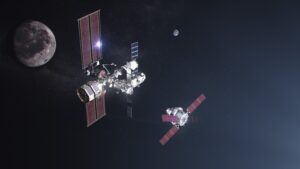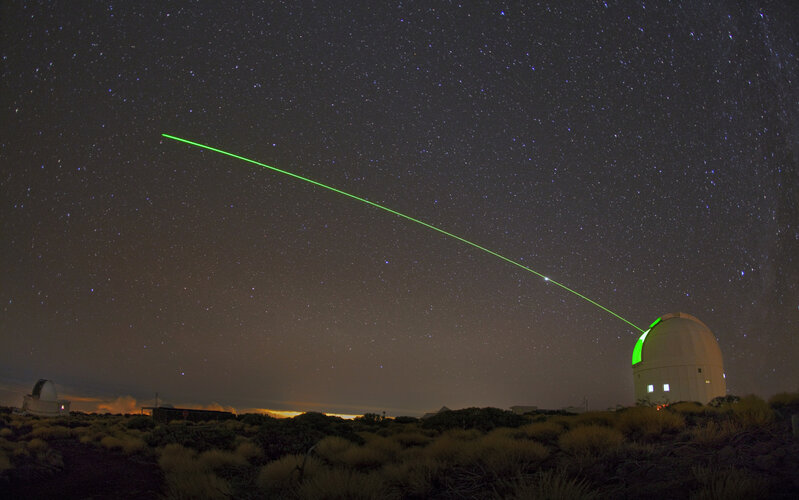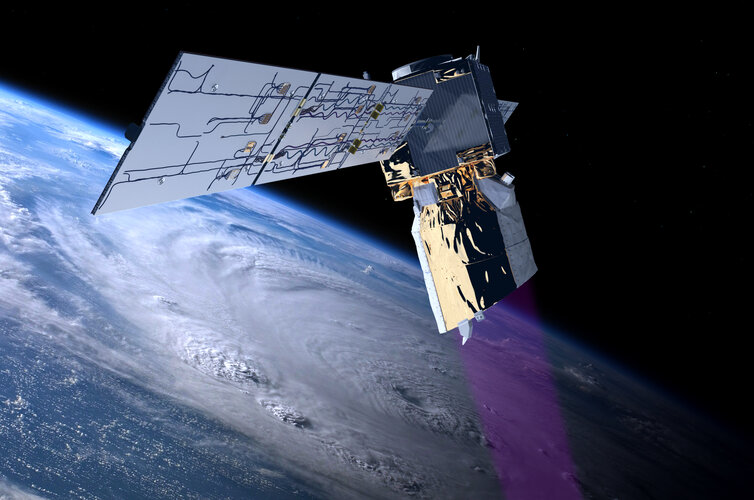Mars was covered by 300 meter deep oceans
Friday, 18 November 2022 12:11 Mars is called the red planet. But once, it was actually blue and covered in water, bringing us closer to finding out if Mars had ever harboured life.
Most researchers agree that there has been water on Mars, but just how much water is still debated.
Now a study from the University of Copenhagen shows that some 4.5 billion years ago, there was enough water for the entire planet to be
Mars is called the red planet. But once, it was actually blue and covered in water, bringing us closer to finding out if Mars had ever harboured life.
Most researchers agree that there has been water on Mars, but just how much water is still debated.
Now a study from the University of Copenhagen shows that some 4.5 billion years ago, there was enough water for the entire planet to be First privately built Indian space rocket launches
Friday, 18 November 2022 12:11 The first privately developed Indian rocket lifted off into the upper reaches of the atmosphere on Friday, in another milestone in the country's push to become a major space power.
The half-tonne Vikram-S rocket launched before midday local time and travelled in an arc, live footage from the Indian Space Research Organisation (ISRO) showed.
It safely splashed down into the sea six minute
The first privately developed Indian rocket lifted off into the upper reaches of the atmosphere on Friday, in another milestone in the country's push to become a major space power.
The half-tonne Vikram-S rocket launched before midday local time and travelled in an arc, live footage from the Indian Space Research Organisation (ISRO) showed.
It safely splashed down into the sea six minute Perseverance investigates intriguing Martian bedrock
Friday, 18 November 2022 12:11 NASA's Perseverance Mars rover has begun exploring an area the science team calls "Yori Pass" near the base of Jezero Crater's ancient river delta. They've been eager to explore the region for several months after spotting a rock similar to one Perseverance collected samples from in July.
The feature is so tantalizing to the scientists because it is sandstone, which is composed of fine gra
NASA's Perseverance Mars rover has begun exploring an area the science team calls "Yori Pass" near the base of Jezero Crater's ancient river delta. They've been eager to explore the region for several months after spotting a rock similar to one Perseverance collected samples from in July.
The feature is so tantalizing to the scientists because it is sandstone, which is composed of fine gra Humanity to go back to the moon. Ukrainian contribution to the space science
Friday, 18 November 2022 12:11 November 16, 2022, was a big day for all space industry fans. Artemis I, a first mission to the Moon after a break that lasted over 53 years, is finally launched. And while the eyes of millions were directed towards their screens to see the launch, only some people recognize the contributions of different countries to this achievement of humanity. In particular, the scientific contribution of Uk
November 16, 2022, was a big day for all space industry fans. Artemis I, a first mission to the Moon after a break that lasted over 53 years, is finally launched. And while the eyes of millions were directed towards their screens to see the launch, only some people recognize the contributions of different countries to this achievement of humanity. In particular, the scientific contribution of Uk Massive Volcanism May Have Altered Ancient Venus' Climate
Friday, 18 November 2022 12:11 Volcanic activity lasting hundreds to thousands of centuries and erupting massive amounts of material may have helped transform Venus from a temperate and wet world to the acidic hothouse it is today, a NASA paper suggests.
The paper also discusses these "large igneous provinces" in Earth's history which caused several mass extinctions on our own planet millions of years ago.
"By und
Volcanic activity lasting hundreds to thousands of centuries and erupting massive amounts of material may have helped transform Venus from a temperate and wet world to the acidic hothouse it is today, a NASA paper suggests.
The paper also discusses these "large igneous provinces" in Earth's history which caused several mass extinctions on our own planet millions of years ago.
"By und Webb observations point to a shorter cosmic dark age
Friday, 18 November 2022 12:11 The first galaxies may have formed far earlier than previously thought, according to observations from the James Webb Space Telescope that are reshaping astronomers' understanding of the early universe.
Researchers using the powerful observatory have now published papers in the journal Astrophysical Journal Letters, documenting two exceptionally bright, exceptionally distant galaxies, based
The first galaxies may have formed far earlier than previously thought, according to observations from the James Webb Space Telescope that are reshaping astronomers' understanding of the early universe.
Researchers using the powerful observatory have now published papers in the journal Astrophysical Journal Letters, documenting two exceptionally bright, exceptionally distant galaxies, based Webb draws back curtain on universe's early galaxies
Friday, 18 November 2022 12:11 A few days after officially starting science operations, NASA's James Webb Space Telescope propelled astronomers into a realm of early galaxies, previously hidden beyond the grasp of all other telescopes until now.
"Everything we see is new. Webb is showing us that there's a very rich universe beyond what we imagined," said Tommaso Treu of the University of California at Los Angeles, princ
A few days after officially starting science operations, NASA's James Webb Space Telescope propelled astronomers into a realm of early galaxies, previously hidden beyond the grasp of all other telescopes until now.
"Everything we see is new. Webb is showing us that there's a very rich universe beyond what we imagined," said Tommaso Treu of the University of California at Los Angeles, princ Astronomers capitalize on early access to James Webb Space Telescope data
Friday, 18 November 2022 12:11 First in line to receive data transmissions from the James Webb Space Telescope, a team of astronomers at the University of California, Irvine and other institutions is using the unprecedentedly clear observations to reveal the secret inner workings of galaxies.
In a paper published in The Astrophysical Journal Letters, the researchers describe their examination of the nearby galaxy NGC 74
First in line to receive data transmissions from the James Webb Space Telescope, a team of astronomers at the University of California, Irvine and other institutions is using the unprecedentedly clear observations to reveal the secret inner workings of galaxies.
In a paper published in The Astrophysical Journal Letters, the researchers describe their examination of the nearby galaxy NGC 74 NASA Webb Telescope micrometeoroid mitigation update
Friday, 18 November 2022 12:11 Micrometeoroid strikes are an unavoidable aspect of operating any spacecraft. NASA's James Webb Space Telescope was engineered to withstand continual bombardment from these dust-sized particles moving at extreme velocities, to continue to generate groundbreaking science far into the future.
"We have experienced 14 measurable micrometeoroid hits on our primary mirror, and are averaging one
Micrometeoroid strikes are an unavoidable aspect of operating any spacecraft. NASA's James Webb Space Telescope was engineered to withstand continual bombardment from these dust-sized particles moving at extreme velocities, to continue to generate groundbreaking science far into the future.
"We have experienced 14 measurable micrometeoroid hits on our primary mirror, and are averaging one Hundreds of Renesas rad-hard chips protecting Artemis 1 on lunar mission
Friday, 18 November 2022 12:11 Renesas Electronics Corporation (TSE:6723), a premier supplier of advanced semiconductor solutions, has announced that hundreds of its radiation-hardened (rad-hard) integrated circuits (ICs), including over 50 different part numbers, are onboard the Artemis 1 launch that blasted off on November 16.
Intersil-brand rad-hard ICs are part of the battery management systems, RS-25 engine control
Renesas Electronics Corporation (TSE:6723), a premier supplier of advanced semiconductor solutions, has announced that hundreds of its radiation-hardened (rad-hard) integrated circuits (ICs), including over 50 different part numbers, are onboard the Artemis 1 launch that blasted off on November 16.
Intersil-brand rad-hard ICs are part of the battery management systems, RS-25 engine control X-37B orbital test vehicle concludes sixth mission
Friday, 18 November 2022 12:11 The X-37B Orbital Test Vehicle-6 (OTV-6), the U.S. Space Force's unmanned, reusable spaceplane, successfully deorbited and landed at NASA's Kennedy Space Center Shuttle Landing Facility on Nov. 12, 2022, at 05:22 a.m.
OTV -6 was the first mission to introduce a service module-a ring attached to the rear of the vehicle expanding the number of experiments that can be hosted during a mission.
The X-37B Orbital Test Vehicle-6 (OTV-6), the U.S. Space Force's unmanned, reusable spaceplane, successfully deorbited and landed at NASA's Kennedy Space Center Shuttle Landing Facility on Nov. 12, 2022, at 05:22 a.m.
OTV -6 was the first mission to introduce a service module-a ring attached to the rear of the vehicle expanding the number of experiments that can be hosted during a mission. U.S. military space plane lands, ending record-breaking mission
Friday, 18 November 2022 12:11 The U.S. military's X-37B space plane finally came back to Earth on Saturday after spending 908 days in orbit.
The robotic X-37B Orbital Test Vehicle-6 touched down at NASA's Kennedy Space Center in Florida at 5:22 a.m. The 908 days in orbit was four months longer than any previous X-37B flight.
The plane, which was built by Boeing, also carried a service module for the first tim
The U.S. military's X-37B space plane finally came back to Earth on Saturday after spending 908 days in orbit.
The robotic X-37B Orbital Test Vehicle-6 touched down at NASA's Kennedy Space Center in Florida at 5:22 a.m. The 908 days in orbit was four months longer than any previous X-37B flight.
The plane, which was built by Boeing, also carried a service module for the first tim Japan agrees to space station extension and Gateway contributions
Friday, 18 November 2022 11:30
The Japanese government has formally agreed to extend its participation on the International Space Station through 2030 and provide components for the lunar Gateway.
The post Japan agrees to space station extension and Gateway contributions appeared first on SpaceNews.
ESA’s site for laser and quantum links marks 25 years
Friday, 18 November 2022 11:30
ESA’s Optical Ground Station, perched high on the slopes of Tenerife’s Mount Teide volcano, has now been peering skyward for a quarter of a century. Originally designed for laser-based communications with satellites, it is today additionally employed for tracking space debris and near-Earth asteroids as well as supporting world-class science: this year’s Physics Nobel Prize winner used the station for a quantum teleportation experiment that extended to the neighboring island of La Palma.
Putting a value on ESA’s Aeolus wind mission
Friday, 18 November 2022 11:20
Over the last four years, ESA’s Aeolus mission has been delivering unique profiles of Earth’s winds from space, improving operational weather forecasts, climate models and more – all showing that its novel laser technology is advancing science and being used for important practical applications. Adding to the list of Aeolus’ successes, a recent report highlights that the mission has also brought economics benefits to Europe to the tune of €3.5 billion, and that a follow-on mission could more than double this figure.

